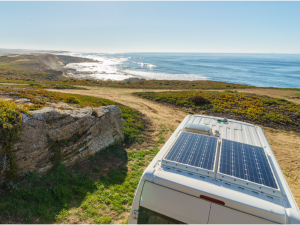RV Travel in 2022: Best Tips for Keeping Safe on Your Next RV Road Trip

One of the best ways to travel and see the country from coast to coast is to take all the comforts of home along with you. And RV travel offers anyone this lifestyle.
Recent data has shown that more Millennials than ever before have begun embracing the RV lifestyle, and a lot of this has to do with the recent onset of the COVID-19 pandemic. This combined with a surging population of digital nomads has brought RVs back into popularity.
However, RV travel should come with a few warnings. And this is because driving an RV isn’t like driving a car or a truck. As such, greater safety protocols need to be followed to ensure that you have a safe traveling experience.
Here, we’ll explore a few of the best safety practices to follow while traveling cross-country with your RV.
Vehicle Maintenance & Safety
Maintaining an RV takes a lot more work than a typical passenger car. In fact, upkeep with an RV is a lot like maintaining a home, and you’ll have to take a few extra things into consideration.
First, keeping your engine maintained is going to be your main priority. As such, ensure that you take your RV in for service after every trip. And if your RV has sat idle for a while, a trip to the service shop before a planned trip is a great strategy.
Additionally, you don’t want to be stuck on the roadside without a safety kit. So ensure that you have spare tires, a tire patching kit, and road safety devices such as cones or flares.
Along these same lines, make sure that your insurance covers your RV prior to any trip. And if not, shop insurance quotes and choose a suitable policy before heading out for any long-distance travel.
Plan an Alternate Stopping Point
In 2020 and 2021, road travel increased by a large percentage as many people chose to avoid dealing with mass transit and airlines because of the COVID-19 pandemic. As a result, many travelers who attempted to stay at campgrounds or RV parks found services at full capacity.
One of the last things you’ll want to experience after driving for half a day is to find your destination completely full. But if you plan on an alternate destination just in case, you won’t have to worry about driving for another 300 miles just to park your RV.
Alternate destinations also offer you the chance to explore a different part of the country. And you may be quite delighted by what you might find by deviating from your original plan as well.
Remember, keep your trip flexible and you’re more likely to have a much better experience.
Know the Signs of Distracted Drivers
For the last decade or so, smartphones have been responsible for a large number of accidents caused by distracted drivers. And this has actually become worse due to the number of onboard distractions that most modern vehicles contain.
Being able to spot a distracted driver is going to be your greatest defense for avoiding an accident. And thankfully, there are several signs that you can look for including some of the following:
- Frequent or abrupt swerving
- Riding or drifting along the shoulder
- Grazing the median repeatedly
- Following too closely
- Frequently braking
- Visibly noticing the driver’s head down
- Not maintaining a consistent speed
The above list illustrates the more common ways to spot a distracted driver. And if you do find yourself around distracted drivers, your best defense for staying safe is to keep your distance at all times.
RV life can be one of the more freeing lifestyles around. And this is simply because an RV allows you to travel the country with all of the comforts of home at your disposal, and you won’t have to spend a fortune on lodging. But unless you learn how to stay safe on the road, your trip might turn into a nightmare.






